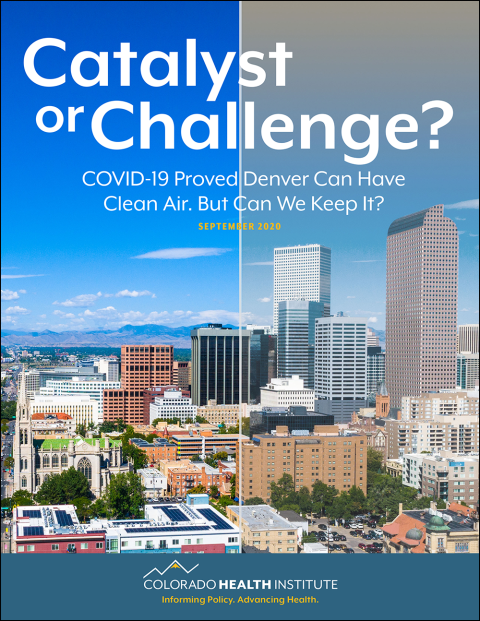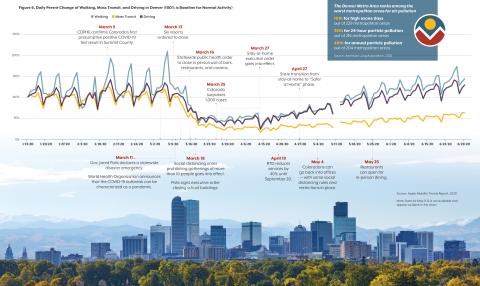Takeaway 3
Emergency measures taken during the pandemic cleaned Denver’s air, but the effects will be difficult to replicate.
In March and April 2020, people really did stay at home, driving less to offices and stores. That led to cleaner skies in Denver temporarily. But freezing the economy and asking people to never drive again are not realistic long-term solutions. Nevertheless, the pandemic has demonstrated something very important: Coordinated behavior change can clean our air.
Now is a good time to pause and reflect on what pragmatic solutions Coloradans can take to clean the air. What policies and other approaches can policymakers, government officials, and leaders in the community consider, and what is being considered to catalyze change? What challenges do those solutions present? What are the pathways to progress?
Solution 1:
Improve Options for Mobility (Mass Transit and Bike Lanes)
Opportunity to Catalyze:
Getting more people to use alternative transportation like biking, taking transit, and walking results in less health-harming pollution in the air.
Challenges:
• Social distancing and crowded public transportation.
Since March, use of mass transit has dropped dramatically in Denver. As of August 31, 2020, use was half of its pre-pandemic level on January 13, while driving has all but returned to normal. People are hesitant to take public transportation during the pandemic, and the U.S. Centers for Disease Control and Prevention (CDC) recommends driving alone to work if possible — the exact opposite of what cities have recommended for years.
• The cost of public transportation in Denver is among the highest in the country.
At the beginning of 2019, the Regional Transportation District (RTD) raised prices for bus and train tickets, making Denver the most expensive place to ride transit compared to similar cities. RTD’s adult fare is $3, while the metro in Austin, Texas, for instance, costs $1.25. RTD does offer discounts for children and those with incomes at or below 185% of the federal poverty level, but cost remains a barrier for many. According to the Colorado Department of Transportation (CDOT), RTD saw ridership decline 3% from 2010-2020, even prior to the pandemic, likely due to the fare increases and frustration with lack of routes and on-time performance.
Pathway to Progress:
In 2017, the City and County of Denver put forth a Mobility Action Plan to give people better choices to get around. The plan states that Denver’s population continues to grow, and 73% of Denver commuters drive alone. The Mobility Action Plan aims to reduce single occupancy vehicles by 50%, increasing the percentage of bike and pedestrian commuters to 15% and transit commuters to 15%.
Mass transit operators will need to ensure the safety of passengers and communicate it clearly. The CDC recommends trains and buses follow social distancing guidelines by implementing rear boarding, keeping seats six feet apart, allowing fewer riders per vehicle, and sanitizing the vehicles. RTD has taken measures to ensure proper social distancing and limit riders on buses and trains. Riders have been required to wear masks since April. Clear communication of these safety measures to the public may be a key to winning back riders.
• Decrease barriers to accessing alternative transportation.
RTD suspended fare collection temporarily during the first months of the pandemic to maintain distancing between drivers and riders. Could fares be suspended for good? Passenger fares made up 14.4% of RTD’s billion-dollar budget in 2019, while more than 60% of its funding came from sales taxes, according to the agency’s most recent annual report. The passenger fares could be made up in a small sales tax increase or through a variety of state or local tax schemes. Free service could bring back riders, especially while unemployment is at an all-time high and the COVID-19 economy continues to make life difficult.
Improving access to bikes and scooters for lower-income Denver residents and creating more bike-friendly streets can offer options for getting around that do not pollute the air. Like most American cities, Denver was built for cars. The pandemic could be catalyst to change that, as many cities are transforming their streets to include more bike lanes and pedestrian zones, with a shift toward getting cars off the roads. As part of the “Can Do Colorado” initiative, Denver agencies are offering a variety of grants for e-bikes and e-scooters for workers with low incomes.
Solution 2:
Electrify the Vehicle Fleet
Opportunity to Catalyze:
Increase access to zero emissions vehicles (ZEVs) and charging stations that power them to reduce air pollution.
Challenges:
• ZEVs and charging stations are not widely available.
ZEVs will replace gas-powered cars only if they become more available and affordable. Colorado has the seventh-highest rate of ZEV sales in the nation at 2.6%, which is double the national average.24 Data from the Colorado Automobile Dealers Association also show that 77.7% of cars purchased by Coloradans are light trucks (pickups, sport utility vehicles, crossover utility vehicles, and vans). None of the ZEVs sold in 2018 were light trucks.
Charging station availability has often been a concern as well, as ZEV owners wanting to travel long distances must ensure they have stations where they can charge their cars.
ZEVs are expensive. The best-selling ZEV in Colorado is made by Tesla. The starting price for the cheapest Tesla is nearly $40,000 — too expensive for most Coloradans. Tack on the recession and rising unemployment due to the pandemic, and price becomes a significant barrier to getting more clean cars on the road.
Pathway to Progress:
Between January 2015 and August 2020, the number of registered ZEVs in Colorado increased more than five-fold, surpassing 29,000 cars, and now there are 39 models to choose from in Colorado, up from 12 just two years ago.25 While a significant increase, this is just 0.5% of the 5.3 million registered cars in Colorado.
Colorado became the 11th state (and first non-coastal state) to adopt a ZEV mandate in August 2019. This mandate requires at least 5% of an automaker’s new car lineup to be electric vehicles by 2023 and more than 6% by 2025. The mandate creates more availability for a diverse variety of ZEVs to choose from, increasing choices for the majority of Coloradans who prefer SUVs.
The ZEV mandate is a small step in the right direction, but addressing the cost barrier is important as well. Colorado has historically provided tax credits up to $5,000 on new electric vehicle purchases. This scaled back to $4,000 this year and will drop to $2,000 by 2023. Credits for electric trucks will scale back as well.
While ZEVs are expected to get cheaper over the next few years, studies show that tax credits and rebates on ZEVs increase sales by 5.3% for every $1,000 of tax credits.26 A $4,000 credit in 2020 would translate to a 21.2% increase in sales. Maintaining tax credits will likely continue to boost ZEV sales, and as prices fall, tax credits will become less necessary over time. To make these vehicles more accessible, special tax credits for people with incomes below a certain level could be considered to encourage even further adoption of ZEVs and address inequities in access.
Vehicle charging stations continue to pop up in Denver and surrounding cities. But charging stations on remote highways are in short supply. Eight western states — Arizona, Colorado, Idaho, Montana, Nevada, New Mexico, Utah and Wyoming — are devising a framework for creating an Intermountain West electric vehicle corridor. It’s called the “Regional Electric Vehicle Plan for the West,” or “REV West,” and it is laying the groundwork for a multi-state solution to charging. This sort of collaboration is key to creating solutions that work for Colorado and the region to encourage ZEV adoption and reduce emissions.
Solution 3:
Encourage Teleworking to Reduce Commuting
Opportunity to Catalyze:
Encourage teleworking and provide flexibility for workers and reduce emissions from commuting.
Challenge:
• Not everyone can telework.
While many Coloradans are working from home at least part-time, many others cannot work from home. Essential workers like health care providers, grocery store clerks, delivery drivers, janitors, and food servers do not have the privilege to work from home. According to the Bell Policy Center, slightly more than 20% of Colorado workers are essential workers.
• Working from home can be challenging.
Public health guidance encourages workers in Colorado to telecommute if possible. The rapid transition to teleworking may have initially felt like a temporary fix, but it is now being considered as a long-term solution for employers to give workers flexibility and reduce air pollution. However, working from home can present challenges to productivity, technology (WiFi, office set-up, bandwidth issues), social interaction and collaboration, and finding a balance between work and home life as they blend into one another. A national survey by Gensler Research Institute showed that only 12% of U.S. workers want to work from home full-time, while 44% prefer to work part-time from home and 44% prefer the office full-time.27
Pathway to Progress:
Colorado already had the highest rate of people teleworking full-time in the country prior to COVID-19, at 6.9% compared to the national average of 2.6%.28 Efforts to support, invest in, and foster flexible teleworking will be key to continuing its adoption in the long-term. That means ensuring employees have access to the technology they need to work (computers, good WiFi, etc.) and a clear, formalized teleworking policy that ensures flexibility, promotes productivity, and supports the mental health of workers who may feel isolated or lacking in social interaction. At the state level, it means expanding access to broadband in rural and underserved areas of the state where access to reliable, high-speed internet is sparse.
• Support and invest in formalizing and normalizing teleworking.
The Can Do Colorado Community Challenge has two efforts to encourage and support communities and their businesses’ abilities to telework, while reducing air pollution. First, CDOT is offering micro grants up to $5,000 for communities that promote telework best practices to reduce commuter traffic on local roads.
Second, the Denver Regional Council of Governments’ initiative called “Telework Tomorrow” helps employers expand telework practices. It offers free resources and guidance, an implementation toolkit, and support for businesses to update or institute new telework policies.
Solution 4:
Transition from Fossil Fuels to Renewables for Electricity
Opportunity to Catalyze:
In the absence of federal efforts to address climate change and improve air, Colorado has an opportunity to be a model for other states by transitioning to renewable energy generation.
Challenge:
• The federal government is rolling back emissions regulations and environmental protections.
President Donald Trump has pursued a deregulatory approach to energy development and emissions regulation. In his first month in office, he issued an executive order that for every new regulation put in place, two had to be eliminated. Trump has long questioned the efficacy of renewable energy sources, suggested that wind turbines could cause cancer, and vocally advocated for coal as a source of power. Trump withdrew the United States from the Paris Agreement on climate change and replaced the Obama-era Clean Power Plan that aimed to reduce greenhouse emissions from power plants. As of August 2020, the Trump administration had taken 74 actions to weaken environmental protection. One of those actions is a new fuel efficiency standard released in March 2020 that the Trump administration describes as “the largest deregulatory initiative of this administration.” It calls for fuel economy and emission standards to increase by 1.5% annually, rather than 5%, curbing efforts to reduce emissions from gas-powered cars.
Pathway to Progress:
In direct contrast to the federal approaches to environmental protection and regulation, Polis has made environmental protection a cornerstone of his administration, vowing 100% renewable energy by 2040. The Can Do Colorado Community Challenge has set “Improving Air Quality” as one of its three major goals.
As Coloradans consider policies and actions to reduce air pollution and protect the public’s health, higher targets for clean energy could be an opportunity to set an example for environmental action for the rest of the country during and after the pandemic.
• Invest in renewable energy to power buildings.
Colorado is a leader in renewable energy development, with investments in wind, solar, and other renewable energy resources. In 2004, the state passed the first voter-led renewable energy standard in the nation, requiring electricity utilities to obtain a percentage of their power from renewable energy sources. As powering buildings and generating electricity make up nearly half of emissions in Colorado, a significant transition to renewable energy is an opportunity to make the biggest impact on reducing emissions. Xcel Energy, Colorado’s largest electric utility, plans to be 80% carbon-free by 2030 and 100% carbon-free by 2050, with all energy coming from renewable sources. However, Xcel supplies just over half of Colorado’s electricity. The rest comes from dozens of smaller suppliers, including rural electric cooperatives and city-owned utilities, which have not made the same commitment.
Recent advances in technology and cheaper manufacturing costs make renewable sources like wind and solar cost-effective. In fact, wind energy has become the cheapest option for utilities building new electric generation. Colorado’s electricity from renewable sources has more than doubled since 2010 to 25% of net generation in 2019, led by increased wind and solar power.
• Build on existing climate policy to reflect pandemic considerations.
Colorado’s legislature passed a first of its kind “Climate Action Plan To Reduce Pollution” in 2019, making it the first state to put into statute both strong short-term and long-term goals for cutting climate pollution emissions and the regulations to achieve the goals. The goal is to cut climate pollution (relative to 2005 levels) by 90% by 2050, putting Colorado in line with Paris Agreement goals. Cutting climate pollution would also reduce other criteria air pollutants, since the same sources that produce carbon dioxide also produce health-harming emissions. As this law continues to go through rulemaking, it’s imperative that the connection to COVID-19, air pollution, and mortality among disproportionately impacted communities is reflected.
Colorado also passed a first-of-its kind oil and gas regulation bill in 2019 with Senate Bill 181, which requires state regulators to put health and safety first when it comes to oil and gas extraction activities and gives local governments increased say over oil and gas development in their area. The bill also strengthened the Colorado Oil and Gas Conservation Commission by transitioning it from a voluntary board of seven members to a full-time five-member committee focused on regulating oil and gas development with a focus on protecting public health and the environment. A majority of the members have extensive public health and environment backgrounds, a nod toward the direction the commission is taking.
• Expand monitoring of air pollution.
To clean the air in Denver and the Front Range, a better understanding of emissions through expanded monitoring resources is needed. This summer, Colorado passed Senate Bill 204, aimed at enhancing the state’s ability to improve air quality and protect public health and the environment by providing CDPHE’s Air Pollution Control Division with new resources for monitoring, inspection, and enforcement. The law increases the capacity to monitor air pollution sources, resulting in informing better emissions reduction strategies, better tracking of oil and gas leaks, and advancing science and research through data collection.
Conclusion
The pandemic-driven clearing of Denver’s brown cloud was temporary, but does it have it be? As the economy continues to open up, traffic returns to normal, and Coloradans’ behavior starts to resemble life before the pandemic, there is an opportunity to consider what individual, community, and societal changes can ensure healthier, cleaner skies are with us for the long-term.
For the last decade, Colorado has been headed in the right direction for some – but not all – air pollutants. But the blue skies of spring 2020 were a reminder that there is room for significant improvement.
Looking ahead, employers, policymakers, and local leaders all have a role in reducing emissions. This might look like employers continuing to encourage hybrid or full-telecommuting, policymakers transitioning Colorado to renewable energy, and people retaining the healthy habits they might have developed during lockdown, such as walking and biking more and taking fewer unnecessary car trips.
Taking steps to clean Colorado’s air will not be without challenges. But the pandemic and its aftermath have presented a unique time to pause, take a deep breath, and work through the challenges today so all Coloradans can breathe easier tomorrow.




